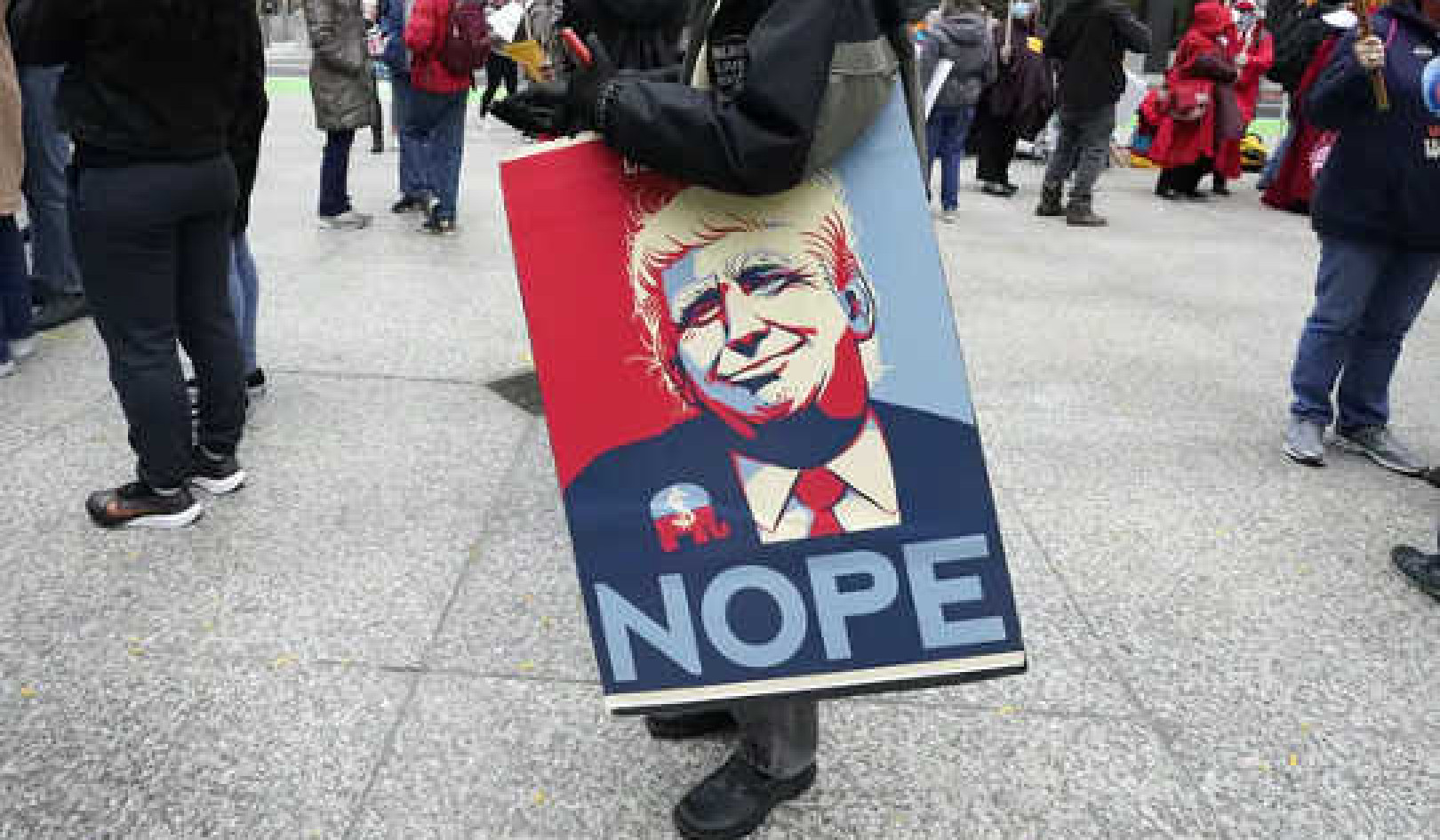
Every time we face a new inflation-related challenge, it takes a different form and requires a different set of solutions. THE CANADIAN PRESS/Graham Hughes
With the Bank of Canada announcing an oversized interest rate hike this week, it might seem like central banks are coming to rescue us from inflation once again. Yet while they did play an important role in mitigating a COVID-induced recession, central banks don’t have the power to solve our inflation problem.
There’s no question that the inflation outlook today is worrying. With inflation hitting 5.7 per cent in March, we are facing a perfect storm of inflationary pressures from a combination of supply chain bottlenecks, pent-up demand and massive increases in energy prices from Russian sanctions.
As politicians start to make noise about inflation, we need to be careful not to accept the outdated assumption that central banks can control inflation by limiting the money supply.
Conservative Party leadership hopeful Pierre Poilievre recently asserted that the solution to inflation is to “stop the central bank from printing money to pay for government spending.” This is not only factually incorrect (the Bank of Canada stopped purchasing large amounts of government bonds back in October of last year), but also outdated.
The legacy of monetarism
Back in the late 1970s and early 1980s, Ronald Reagan and Margaret Thatcher capitalized on public anxiety around rising prices by bringing their conservative governments into power on the promise of getting tough on inflation using monetarism.
We should not be too surprised, then, to see the legacy of this outdated economic policy living on in members of the Conservative Party of Canada.e
Poilievre has resurrected the age-old theory — let’s call it quack monetarism — that inflation is caused by too much money circulating in the economy and that the solution is to reduce the central bank’s money creation. Inflation has never only been about money; central banks can’t just wave a magic wand and get it down again.
The limits of monetary policy
While central banks do play an important part in getting inflation under control by setting interest rates, they don’t have all the tools needed to get inflation down this time around — particularly when some of the dynamics driving price increases will not respond to changes in interest rates.
As writer Adam Tooze points out, monetary policy can’t improve bottlenecks in the supply of microchips — which are driving car prices higher — or increase the supply of gas.
Even when monetary policy is effective in getting inflation down, there is always the risk of the central bank overshooting its aims and pushing the economy into a recession — as a growing number of policy-makers worry may happen today.
Quack monetarism
So why do conservative politicians like Poilievre want us to believe we can solve this problem by getting the central bank to stop printing money? This is the kind of “zombie idea” that won’t die, in spite of being proven wrong, because its simplicity is so politically appealing.
This claim harks back to Milton Friedman’s famous dictum that inflation is “always and everywhere a monetary phenomenon.” The monetarist theory that Friedman advocated and which became very influential in the 1970s and early 1980s assumed the solution to inflation was to limit the expansion of the money supply.
What’s wrong with this idea? American banker Henry Wallich famously responded to Friedman’s statement by replying, “inflation is a monetary phenomenon in the same way that shooting someone is a ballistic phenomenon.” In other words, an excess of money may be partly to blame for inflation, but if you want to truly solve it, you need to understand the underlying causes of the problem.
As political economist Matthew Watson has shown, economists keep changing their minds about the broader causes of inflation: shifting from pointing a finger at international balance of payments shocks in the 1960s to the oil crisis in the 1970s, the “wage-push” inflation in the 1980s, governments’ lack of anti-inflation credibility in the 1990s and finally the problem of unanchored inflation expectations in the past few decades.
Even if today’s inflation had similar causes to the 1970s, we don’t want to try monetarism again. Central banks in Canada, the United States and the United Kingdom all tried it in the late 1970s. By 1982 they had given up on it because monetarism simply did not work.
Most money is actually created by private banks and so attempts by the central bank to limit the money supply are doomed to failure. The bank can influence the demand for money by increasing or decreasing interest rates, but does not control the money supply itself.
Monetary policy is a blunt instrument
What finally did get inflation down in the 1980s was a combination of punishingly high interest rates — over 21 per cent in Canada — and the most painful recession since the Great Depression, with unemployment rising to 12.8 per cent in Canada. This is not an experience that we want to repeat.
If the economic trauma of 1970s and 1980s teaches us anything, it’s that monetary policy can be a very blunt instrument. To be truly effective, it must often be brutal.
While there are no simple solutions to our current inflationary challenges, it’s clear we need a holistic approach. U.S. President Biden’s recent strategy provides one promising alternative. His goal is to tackle inflation by pressing companies to reduce costs, rather than wages, and by making prescription drugs, energy and childcare more affordable.
So the next time a politician tries to sell you on a quack monetarist remedy for our current inflationary woes, ask them if they’re willing to make us all pay the costs of another historic economic blunder.![]()
About The Author
Jacqueline Best, Professor, School of Political Studies, L’Université d’Ottawa/University of Ottawa
This article is republished from The Conversation under a Creative Commons license. Read the original article.
Recommended books:
Capital in the Twenty-First Century
by Thomas Piketty. (Translated by Arthur Goldhammer)
 In Capital in the Twenty-First Century, Thomas Piketty analyzes a unique collection of data from twenty countries, ranging as far back as the eighteenth century, to uncover key economic and social patterns. But economic trends are not acts of God. Political action has curbed dangerous inequalities in the past, says Thomas Piketty, and may do so again. A work of extraordinary ambition, originality, and rigor, Capital in the Twenty-First Century reorients our understanding of economic history and confronts us with sobering lessons for today. His findings will transform debate and set the agenda for the next generation of thought about wealth and inequality.
In Capital in the Twenty-First Century, Thomas Piketty analyzes a unique collection of data from twenty countries, ranging as far back as the eighteenth century, to uncover key economic and social patterns. But economic trends are not acts of God. Political action has curbed dangerous inequalities in the past, says Thomas Piketty, and may do so again. A work of extraordinary ambition, originality, and rigor, Capital in the Twenty-First Century reorients our understanding of economic history and confronts us with sobering lessons for today. His findings will transform debate and set the agenda for the next generation of thought about wealth and inequality.
Click here for more info and/or to order this book on Amazon.
Nature's Fortune: How Business and Society Thrive by Investing in Nature
by Mark R. Tercek and Jonathan S. Adams.
 What is nature worth? The answer to this question—which traditionally has been framed in environmental terms—is revolutionizing the way we do business. In Nature’s Fortune, Mark Tercek, CEO of The Nature Conservancy and former investment banker, and science writer Jonathan Adams argue that nature is not only the foundation of human well-being, but also the smartest commercial investment any business or government can make. The forests, floodplains, and oyster reefs often seen simply as raw materials or as obstacles to be cleared in the name of progress are, in fact as important to our future prosperity as technology or law or business innovation. Nature’s Fortune offers an essential guide to the world’s economic—and environmental—well-being.
What is nature worth? The answer to this question—which traditionally has been framed in environmental terms—is revolutionizing the way we do business. In Nature’s Fortune, Mark Tercek, CEO of The Nature Conservancy and former investment banker, and science writer Jonathan Adams argue that nature is not only the foundation of human well-being, but also the smartest commercial investment any business or government can make. The forests, floodplains, and oyster reefs often seen simply as raw materials or as obstacles to be cleared in the name of progress are, in fact as important to our future prosperity as technology or law or business innovation. Nature’s Fortune offers an essential guide to the world’s economic—and environmental—well-being.
Click here for more info and/or to order this book on Amazon.
Beyond Outrage: What has gone wrong with our economy and our democracy, and how to fix it -- by Robert B. Reich
 In this timely book, Robert B. Reich argues that nothing good happens in Washington unless citizens are energized and organized to make sure Washington acts in the public good. The first step is to see the big picture. Beyond Outrage connects the dots, showing why the increasing share of income and wealth going to the top has hobbled jobs and growth for everyone else, undermining our democracy; caused Americans to become increasingly cynical about public life; and turned many Americans against one another. He also explains why the proposals of the “regressive right” are dead wrong and provides a clear roadmap of what must be done instead. Here’s a plan for action for everyone who cares about the future of America.
In this timely book, Robert B. Reich argues that nothing good happens in Washington unless citizens are energized and organized to make sure Washington acts in the public good. The first step is to see the big picture. Beyond Outrage connects the dots, showing why the increasing share of income and wealth going to the top has hobbled jobs and growth for everyone else, undermining our democracy; caused Americans to become increasingly cynical about public life; and turned many Americans against one another. He also explains why the proposals of the “regressive right” are dead wrong and provides a clear roadmap of what must be done instead. Here’s a plan for action for everyone who cares about the future of America.
Click here for more info or to order this book on Amazon.
This Changes Everything: Occupy Wall Street and the 99% Movement
by Sarah van Gelder and staff of YES! Magazine.
 This Changes Everything shows how the Occupy movement is shifting the way people view themselves and the world, the kind of society they believe is possible, and their own involvement in creating a society that works for the 99% rather than just the 1%. Attempts to pigeonhole this decentralized, fast-evolving movement have led to confusion and misperception. In this volume, the editors of YES! Magazine bring together voices from inside and outside the protests to convey the issues, possibilities, and personalities associated with the Occupy Wall Street movement. This book features contributions from Naomi Klein, David Korten, Rebecca Solnit, Ralph Nader, and others, as well as Occupy activists who were there from the beginning.
This Changes Everything shows how the Occupy movement is shifting the way people view themselves and the world, the kind of society they believe is possible, and their own involvement in creating a society that works for the 99% rather than just the 1%. Attempts to pigeonhole this decentralized, fast-evolving movement have led to confusion and misperception. In this volume, the editors of YES! Magazine bring together voices from inside and outside the protests to convey the issues, possibilities, and personalities associated with the Occupy Wall Street movement. This book features contributions from Naomi Klein, David Korten, Rebecca Solnit, Ralph Nader, and others, as well as Occupy activists who were there from the beginning.
Click here for more info and/or to order this book on Amazon.























